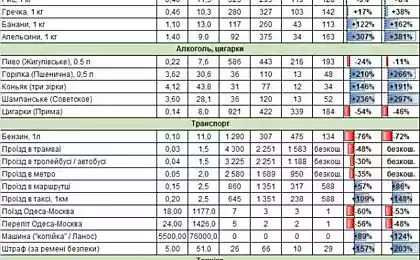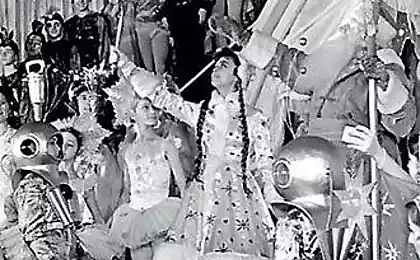216
For some reason, it is believed that in Soviet times people did not know how to have fun, but we always celebrated holidays on a large scale.
How did you remember the Soviet New Year? Here on TV happily chirps the long-awaited "Blue Light", garlands and pussy balls on the Christmas tree shine. From the kitchen tasty pulls grandmother's patties, and the festive table for the New Year blossoms still life of salads, chills and different snacks. And here comes the evening, guests, scarce champagne, dancing and chimes. It was so good!

Many of us have taken a piece of the Union with us and still cherish it in our hearts. We in "Site" We are convinced that the magic of holidays in the USSR has its own simple explanation. This is childhood, youth, the flowering of strength and hope! It is a person who paints a place and gives meaning to things and events, and not vice versa. Agreed? We invite you to the discussion in the comments. In the meantime, let’s remember the classic festive table for the New Year of the USSR.
Having looked into the freezer in the summer to the Soviet hostess, we would surely find a supply of food for the New Year feast. Deficit-c, where without it? The lucky ones managed to get a jar of red or black caviar. In the history of the Union, there was a time when such canned food was loaded or sold at ridiculous prices, but not everyone and not every corner of the country found it. The delicacy was eaten with pancakes and on a white bun with butter.
807897.
Solid-smoked sausage was expensive, rarely appeared on sale, because proudly decorated the table with wealthy and agile owners. The same was true of ham. Juicy and fatty, she went to sandwiches from the best varieties of bread, and lard from the edges was allowed to roast or squarks.
No pickles! Mushrooms home marinade or pickles were able to cook almost all the hostess. There are also classic cucumbers and tomatoes. And in addition, jelly, cold pork legs and dishes from inexpensive and affordable fish. Another thing is sprats. People rushed around the city in sweat to get goldfish in all respects and proudly put on a sandwich.

Spear potatoes, carrots, beets, onions and eggs were not known as exotic, so on the New Year guests were usually offered “Herring under a fur coat” and olives. Salads were cooked literally buckets and fed on the remains of luxury a week after the main feast. This convenient and profitable tradition today pleasantly tickles the stomach on the eve of winter holidays.
From the meat on the festive table sometimes appeared baked chicken or duck. Thin, tortured and sometimes blue, but always natural. They made chops, cutlets, meat rolls, sometimes fryed the liver or served in the form of pate.
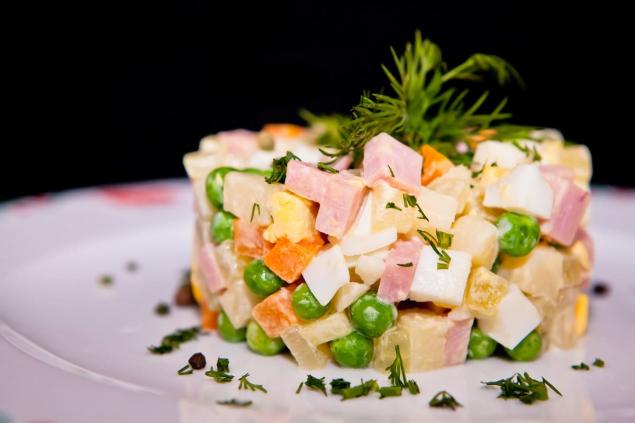
The festive table for the New Year: desserts and drinks First of all candy, which managed to get. More often they were taken in the set, less often - on weight. Children were ready to chew their pom-poms on caps for the scarce chocolate "Bear in the North", "Red poppy", "Karakum" and "Squirrel". Sometimes from the Baltics brought a rare "Cow". It was a great luck to get marshmallows in chocolate or an unaffordable box of cakes for a child.
Housewives were more likely to bake cakes themselves and less likely to buy in the store. Sometimes branded stores "North" threw away ultraresearch - ice cream cake. He was swept away in a moment, and who did not have time, was content with purchased or homemade "Napoleon", "Prague", "Leningrad", "Bird's milk" and other cakes.
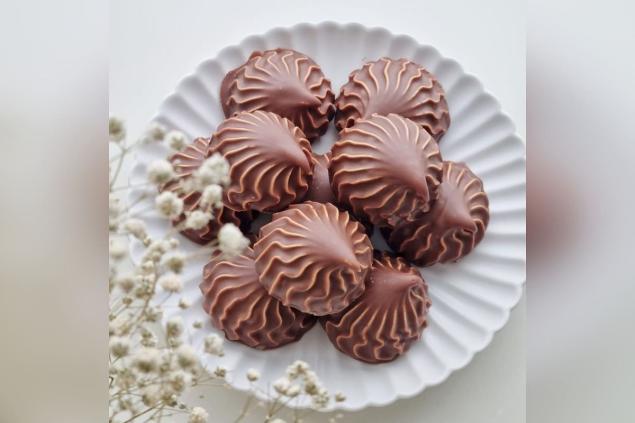
Overseas fruits like unripe bananas were taken by those who were not afraid of large queues. And seasonal tangerines were often small, wrinkled and sour. But many housewives created desserts based on gelatin, coffee, milk, cocoa and frozen berries. Nice and delicious!
In addition to the traditional sparkling, guests were treated to wines, most often Georgian. Less often - vodka and other strong alcoholic beverages. Purchased - yes, but home pourings from cottage raw materials in dense rows occupied the New Year's table. For children, abstainers and for a drink, the owners offered ready-made factory syrups and carbonated water, the benefit of the siphon was in every house.
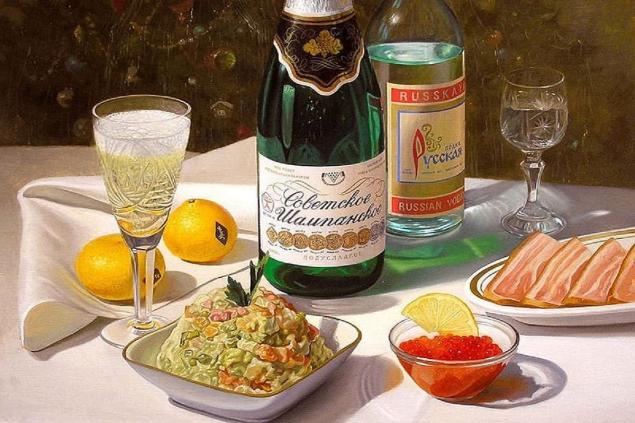
Traditions from the past: leave or get rid of? Despite the modest salaries of ordinary employees and engineers in 80-120 rubles, everyone could afford a big feast, so that even the tables broke. Products for the New Year did not cause damage to the family budget, but the habit of stocking up for the future was firmly deposited in the memory of many generations with the phrase: “Hands off, this is for the New Year!” Life in reserve and today is considered a sign of economics, and the purchase of delicacies for the sake of instant pleasure - waste.
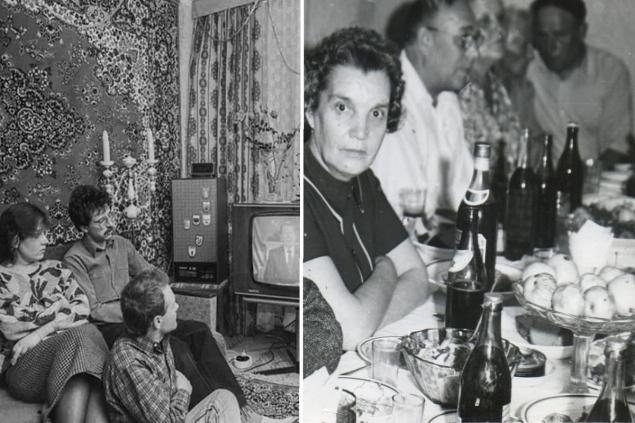
Instagram Yes, recent events in the world have left an imprint on our lives. We are again returning to the precepts of grandfathers and great-grandparents: we make stocks of canned food, candles and matches, dry bread. But when peace comes, how do we choose to move on – fear the future or live in the here and now? Psychologists say: Deferred life syndrome is a path to anxiety, dissatisfaction and sadness.
What moments from the Soviet past remain in your memory? Share it in the comments!

Many of us have taken a piece of the Union with us and still cherish it in our hearts. We in "Site" We are convinced that the magic of holidays in the USSR has its own simple explanation. This is childhood, youth, the flowering of strength and hope! It is a person who paints a place and gives meaning to things and events, and not vice versa. Agreed? We invite you to the discussion in the comments. In the meantime, let’s remember the classic festive table for the New Year of the USSR.
Having looked into the freezer in the summer to the Soviet hostess, we would surely find a supply of food for the New Year feast. Deficit-c, where without it? The lucky ones managed to get a jar of red or black caviar. In the history of the Union, there was a time when such canned food was loaded or sold at ridiculous prices, but not everyone and not every corner of the country found it. The delicacy was eaten with pancakes and on a white bun with butter.
807897.
Solid-smoked sausage was expensive, rarely appeared on sale, because proudly decorated the table with wealthy and agile owners. The same was true of ham. Juicy and fatty, she went to sandwiches from the best varieties of bread, and lard from the edges was allowed to roast or squarks.
No pickles! Mushrooms home marinade or pickles were able to cook almost all the hostess. There are also classic cucumbers and tomatoes. And in addition, jelly, cold pork legs and dishes from inexpensive and affordable fish. Another thing is sprats. People rushed around the city in sweat to get goldfish in all respects and proudly put on a sandwich.

Spear potatoes, carrots, beets, onions and eggs were not known as exotic, so on the New Year guests were usually offered “Herring under a fur coat” and olives. Salads were cooked literally buckets and fed on the remains of luxury a week after the main feast. This convenient and profitable tradition today pleasantly tickles the stomach on the eve of winter holidays.
From the meat on the festive table sometimes appeared baked chicken or duck. Thin, tortured and sometimes blue, but always natural. They made chops, cutlets, meat rolls, sometimes fryed the liver or served in the form of pate.

The festive table for the New Year: desserts and drinks First of all candy, which managed to get. More often they were taken in the set, less often - on weight. Children were ready to chew their pom-poms on caps for the scarce chocolate "Bear in the North", "Red poppy", "Karakum" and "Squirrel". Sometimes from the Baltics brought a rare "Cow". It was a great luck to get marshmallows in chocolate or an unaffordable box of cakes for a child.
Housewives were more likely to bake cakes themselves and less likely to buy in the store. Sometimes branded stores "North" threw away ultraresearch - ice cream cake. He was swept away in a moment, and who did not have time, was content with purchased or homemade "Napoleon", "Prague", "Leningrad", "Bird's milk" and other cakes.

Overseas fruits like unripe bananas were taken by those who were not afraid of large queues. And seasonal tangerines were often small, wrinkled and sour. But many housewives created desserts based on gelatin, coffee, milk, cocoa and frozen berries. Nice and delicious!
In addition to the traditional sparkling, guests were treated to wines, most often Georgian. Less often - vodka and other strong alcoholic beverages. Purchased - yes, but home pourings from cottage raw materials in dense rows occupied the New Year's table. For children, abstainers and for a drink, the owners offered ready-made factory syrups and carbonated water, the benefit of the siphon was in every house.

Traditions from the past: leave or get rid of? Despite the modest salaries of ordinary employees and engineers in 80-120 rubles, everyone could afford a big feast, so that even the tables broke. Products for the New Year did not cause damage to the family budget, but the habit of stocking up for the future was firmly deposited in the memory of many generations with the phrase: “Hands off, this is for the New Year!” Life in reserve and today is considered a sign of economics, and the purchase of delicacies for the sake of instant pleasure - waste.

Instagram Yes, recent events in the world have left an imprint on our lives. We are again returning to the precepts of grandfathers and great-grandparents: we make stocks of canned food, candles and matches, dry bread. But when peace comes, how do we choose to move on – fear the future or live in the here and now? Psychologists say: Deferred life syndrome is a path to anxiety, dissatisfaction and sadness.
What moments from the Soviet past remain in your memory? Share it in the comments!
What was the New Year’s table in the 90s and what has fundamentally changed since then
The prophecy of priest Anatoly Berestov for the coming 2024, we are waiting for something amazing














